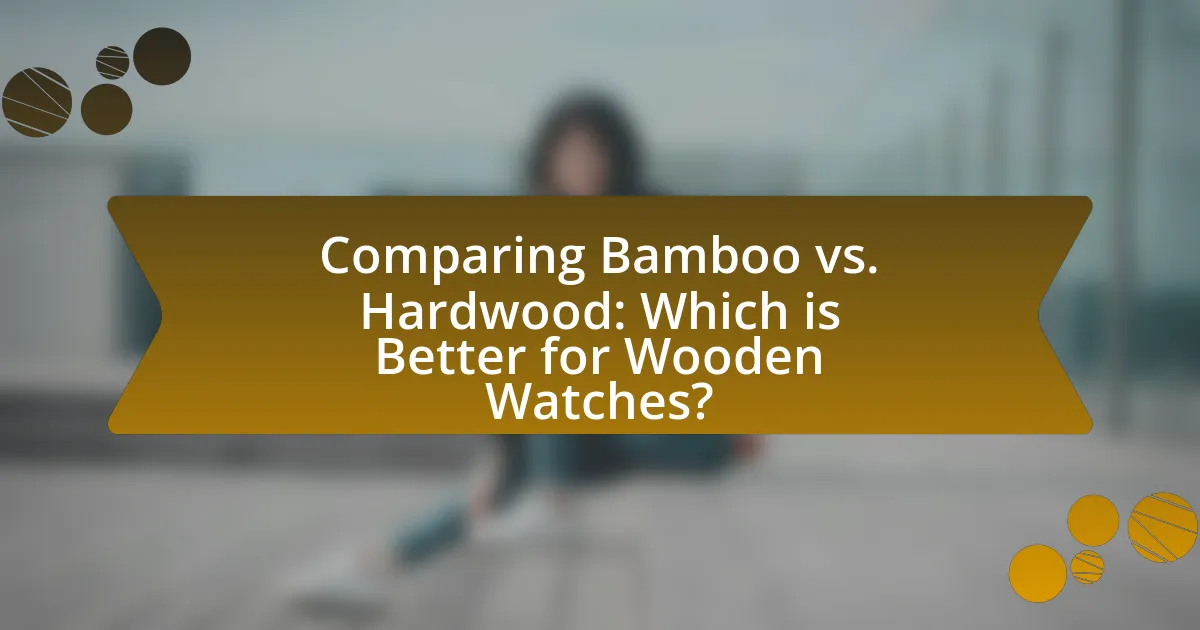The article compares bamboo and hardwood as materials for wooden watches, highlighting their key differences in properties, durability, aesthetics, and environmental impact. Bamboo is noted for its lightweight, flexibility, and rapid growth, making it a sustainable choice, while hardwood offers greater density, durability, and a classic aesthetic. The discussion includes the implications of material choice on watch longevity, comfort, and style, as well as the environmental benefits of bamboo over hardwood. Additionally, the article addresses cost, maintenance requirements, and consumer considerations when selecting between these two materials for wooden watches.

What are the key differences between bamboo and hardwood for wooden watches?
Bamboo and hardwood differ significantly in their properties for wooden watches. Bamboo is lighter, more flexible, and has a faster growth rate, making it a sustainable choice; it can grow up to 35 inches in a single day. In contrast, hardwood, such as oak or walnut, is denser, more durable, and offers a classic aesthetic, often resulting in a longer lifespan for the watch. Additionally, hardwood typically provides a richer color and grain pattern, enhancing the visual appeal. These differences impact not only the weight and comfort of the watch but also its longevity and style, making the choice between bamboo and hardwood dependent on personal preference and intended use.
Why is material choice important in wooden watch design?
Material choice is crucial in wooden watch design because it directly affects durability, aesthetics, and functionality. Different types of wood, such as bamboo and hardwood, offer varying levels of strength, weight, and visual appeal. For instance, hardwoods like oak and maple are known for their robustness and longevity, making them suitable for watches that endure daily wear. In contrast, bamboo is lighter and has a unique grain pattern, appealing to consumers seeking eco-friendly options. The choice of material also influences the watch’s resistance to moisture and temperature changes, which are essential for maintaining accuracy and longevity. Therefore, selecting the appropriate wood type is vital for ensuring the watch meets both practical and aesthetic standards.
How does the choice of material affect durability?
The choice of material significantly affects durability, as different materials possess varying resistance to wear, moisture, and environmental factors. Bamboo, while lightweight and flexible, is generally less durable than hardwood, which is denser and more resistant to scratches and impacts. For instance, hardwoods like oak and maple have a Janka hardness rating that indicates their ability to withstand denting and wear, with values often exceeding 1,000 lbf, whereas bamboo typically scores lower on this scale. This difference in hardness and structural integrity directly influences the longevity and performance of wooden watches made from these materials.
What role does material play in the aesthetics of wooden watches?
Material significantly influences the aesthetics of wooden watches by determining their visual appeal, texture, and overall design. Different types of wood, such as bamboo and hardwood, offer distinct colors, grain patterns, and finishes that contribute to the watch’s unique look. For instance, bamboo typically presents a lighter, more uniform appearance, while hardwoods like walnut or mahogany showcase rich, varied grains and deeper hues. This variety allows consumers to select watches that align with their personal style preferences, enhancing the overall attractiveness of the timepiece. Additionally, the choice of material can affect the watch’s weight and feel, further impacting its aesthetic experience.
What are the environmental impacts of using bamboo versus hardwood?
Using bamboo has a significantly lower environmental impact compared to hardwood. Bamboo is a fast-growing grass that can reach maturity in three to five years, while hardwood trees often take decades to grow. This rapid growth allows for sustainable harvesting without depleting resources. Additionally, bamboo absorbs more carbon dioxide and produces more oxygen than hardwood, contributing positively to air quality.
In contrast, the harvesting of hardwood can lead to deforestation, habitat loss, and increased carbon emissions. For instance, the World Wildlife Fund reports that deforestation contributes to approximately 15% of global greenhouse gas emissions. Furthermore, bamboo cultivation typically requires less water and pesticides than hardwood forestry, making it a more eco-friendly choice.
Overall, bamboo’s rapid renewability and lower resource requirements make it a more sustainable option than hardwood in terms of environmental impact.
How sustainable is bamboo compared to hardwood?
Bamboo is significantly more sustainable than hardwood. Bamboo grows rapidly, reaching maturity in three to five years, while hardwood trees can take decades to mature. This fast growth allows for quicker harvesting and regeneration, making bamboo a renewable resource. Additionally, bamboo absorbs more carbon dioxide and produces more oxygen than hardwood trees, contributing positively to the environment. According to the World Wildlife Fund, bamboo can sequester up to 30% more carbon than hardwood forests, further supporting its sustainability credentials.
What are the carbon footprints associated with each material?
Bamboo has a lower carbon footprint compared to hardwood. Specifically, bamboo absorbs approximately 30% more carbon dioxide during its growth phase than hardwood trees, which contributes to its overall lower emissions. Additionally, bamboo can be harvested every three to five years without killing the plant, allowing for sustainable growth and minimal environmental impact. In contrast, hardwood trees typically take decades to mature, resulting in higher carbon emissions associated with deforestation and slower regrowth. Studies indicate that the carbon footprint of bamboo products can be up to 50% lower than that of hardwood products, making bamboo a more environmentally friendly choice for wooden watches.

What are the advantages of using bamboo for wooden watches?
Bamboo offers several advantages for wooden watches, primarily due to its sustainability, lightweight nature, and durability. As a rapidly renewable resource, bamboo can grow up to three feet in a single day, making it an environmentally friendly choice compared to hardwoods that take decades to mature. Additionally, bamboo is significantly lighter than many hardwoods, which enhances comfort for the wearer. Its natural resistance to moisture and pests contributes to the longevity of bamboo watches, reducing the likelihood of warping or damage over time. These characteristics make bamboo an ideal material for crafting stylish and functional wooden watches.
How does bamboo’s lightweight nature benefit wooden watches?
Bamboo’s lightweight nature significantly benefits wooden watches by enhancing comfort and wearability. This characteristic allows the watches to be worn for extended periods without causing discomfort, making them ideal for daily use. Additionally, the reduced weight contributes to a more balanced design, preventing the watch from feeling cumbersome on the wrist. The lightweight quality of bamboo also facilitates easier manufacturing processes, allowing for intricate designs without compromising structural integrity.
What are the implications of weight on comfort and wearability?
Weight significantly impacts comfort and wearability in wooden watches, as lighter materials generally enhance user comfort during prolonged wear. For instance, bamboo, being less dense than hardwood, results in a lighter watch that reduces strain on the wrist, making it more suitable for everyday use. Studies indicate that lighter watches can lead to higher user satisfaction, as they minimize fatigue and discomfort, particularly for individuals who wear watches for extended periods. In contrast, hardwood watches, while often more durable, can be heavier, potentially leading to discomfort and limiting wearability for some users.
How does bamboo’s flexibility enhance design possibilities?
Bamboo’s flexibility enhances design possibilities by allowing for innovative shapes and structures that are difficult to achieve with more rigid materials. This adaptability enables designers to create intricate and ergonomic forms, making bamboo an ideal choice for products like wooden watches that require both aesthetic appeal and functional comfort. The natural tensile strength of bamboo, which is approximately 28,000 psi, supports its use in various design applications, ensuring durability while maintaining a lightweight profile.
What unique aesthetic qualities does bamboo offer?
Bamboo offers unique aesthetic qualities such as a distinctive grain pattern, a light color palette, and a smooth texture. The grain of bamboo is often straight and uniform, providing a clean and modern look that appeals to contemporary design preferences. Its natural light hues, ranging from pale yellow to light brown, allow for versatility in matching various styles and colors, making it an attractive choice for wooden watches. Additionally, bamboo’s smooth surface enhances its visual appeal and tactile experience, contributing to a refined aesthetic. These qualities make bamboo not only visually striking but also a sustainable option, as it is one of the fastest-growing plants, allowing for eco-friendly production without compromising on style.
How does the grain pattern of bamboo compare to hardwood?
The grain pattern of bamboo is generally straighter and more uniform compared to hardwood, which often exhibits a variety of grain patterns including knots, swirls, and irregularities. Bamboo, being a grass, has a smooth and consistent appearance, while hardwoods like oak or walnut can display intricate designs due to their growth rings and natural imperfections. This uniformity in bamboo can be advantageous for aesthetic purposes in wooden watches, as it provides a sleek and modern look, whereas the diverse patterns in hardwood can add character and uniqueness to each piece.
What color variations can be found in bamboo watches?
Bamboo watches can be found in various color variations, including natural light tan, dark brown, and shades of green. These colors arise from the natural hues of bamboo, which can be enhanced through treatments or finishes. The light tan color is the most common, reflecting the raw appearance of untreated bamboo, while darker shades are achieved through staining or carbonization processes that alter the wood’s color. Additionally, some bamboo watches may feature mixed materials or painted designs, introducing further color diversity.

What are the advantages of using hardwood for wooden watches?
Hardwood offers several advantages for wooden watches, primarily its durability and aesthetic appeal. Unlike softer woods, hardwoods such as oak, maple, and walnut are more resistant to wear and tear, making them ideal for everyday use. Additionally, hardwoods possess a rich grain and color variation that enhances the visual appeal of the watch, providing a unique and luxurious look. The density of hardwood also contributes to better structural integrity, ensuring that the watch maintains its shape and functionality over time. These characteristics make hardwood a preferred choice for high-quality wooden watches.
How does hardwood contribute to the longevity of wooden watches?
Hardwood significantly contributes to the longevity of wooden watches due to its dense structure and natural durability. Unlike softer woods, hardwoods such as oak, maple, and walnut possess a tighter grain, which enhances resistance to wear and tear, moisture, and environmental changes. This inherent strength reduces the likelihood of cracking or warping over time, ensuring that the watch maintains its aesthetic and functional integrity. Studies have shown that hardwoods can last for decades without significant degradation, making them a superior choice for crafting durable timepieces.
What types of hardwood are most commonly used in watchmaking?
The types of hardwood most commonly used in watchmaking include mahogany, maple, and walnut. Mahogany is favored for its durability and rich color, making it a popular choice for high-end watches. Maple is often selected for its fine grain and light color, which provides a modern aesthetic. Walnut is appreciated for its dark, rich tones and strength, contributing to the overall quality and appearance of wooden watches. These hardwoods are chosen for their physical properties and visual appeal, ensuring that the timepieces are both functional and attractive.
How does hardwood’s density affect its performance?
Hardwood’s density significantly affects its performance by influencing strength, durability, and resistance to wear. Denser hardwoods, such as oak and hickory, provide greater structural integrity, making them ideal for applications requiring longevity and resilience, such as wooden watches. Research indicates that higher density correlates with improved hardness and scratch resistance, which are critical for maintaining the aesthetic and functional qualities of wooden timepieces. For instance, a study published in the “Journal of Wood Science” found that denser woods exhibit a higher modulus of rupture, indicating superior strength under stress. This characteristic ensures that hardwood watches can withstand daily wear and tear better than less dense alternatives like bamboo.
What aesthetic benefits does hardwood provide?
Hardwood provides a rich, natural beauty that enhances the aesthetic appeal of wooden watches. The unique grain patterns and colors of hardwood, such as oak, walnut, and cherry, create a visually striking appearance that can complement various styles. Additionally, hardwood’s durability allows it to maintain its luster over time, ensuring that the watch remains attractive even with regular wear. The use of hardwood in watchmaking is often associated with luxury and craftsmanship, further elevating its aesthetic value in the eyes of consumers.
How do the finishes on hardwood compare to those on bamboo?
The finishes on hardwood typically provide a more durable and protective layer compared to those on bamboo. Hardwood finishes, such as polyurethane or varnish, are designed to withstand wear and tear, making them suitable for high-traffic areas and items like wooden watches. In contrast, bamboo finishes often use natural oils or water-based coatings, which may not offer the same level of durability but can enhance the natural appearance of the bamboo. Studies indicate that hardwood finishes can last longer and resist scratches better than bamboo finishes, which tend to require more frequent reapplication to maintain their protective qualities.
What are the visual characteristics that make hardwood appealing?
Hardwood is appealing due to its rich grain patterns, varied colors, and natural luster. The unique grain patterns, such as those found in oak or walnut, create visual interest and depth, making each piece distinct. Additionally, hardwoods exhibit a range of colors, from deep browns to lighter hues, allowing for versatile design options. The natural luster of hardwood, often enhanced by finishes, adds a warm glow that enhances its aesthetic appeal. These characteristics contribute to hardwood’s popularity in high-quality wooden products, including watches, where visual elegance is paramount.

How do bamboo and hardwood compare in terms of cost and availability?
Bamboo is generally more cost-effective and widely available compared to hardwood. Bamboo can be harvested in three to five years, making it a sustainable and rapidly renewable resource, while hardwoods often take decades to mature, leading to higher costs and limited availability. For instance, the price of bamboo flooring can range from $2 to $8 per square foot, whereas hardwood flooring typically costs between $5 and $15 per square foot. This significant price difference, along with bamboo’s faster growth rate, contributes to its greater availability in the market.
What factors influence the pricing of bamboo and hardwood watches?
The pricing of bamboo and hardwood watches is influenced by material quality, craftsmanship, brand reputation, and market demand. High-quality hardwood, such as teak or mahogany, typically costs more due to its durability and aesthetic appeal compared to bamboo, which is lighter and more sustainable but often less expensive. Craftsmanship also plays a significant role; watches with intricate designs or handmade elements command higher prices. Additionally, established brands with a strong reputation can charge premium prices, while market demand fluctuates based on trends and consumer preferences, impacting overall pricing strategies.
How does sourcing impact the cost of each material?
Sourcing significantly impacts the cost of each material by influencing availability, transportation expenses, and market demand. For instance, bamboo, which is often sourced from regions with lower labor costs and abundant supply, tends to be less expensive than hardwood, which may require more extensive harvesting and processing due to its slower growth rate and limited availability in certain areas. Additionally, hardwood sourcing can involve higher transportation costs if the wood is imported from distant locations, further increasing its price. According to a report by the Food and Agriculture Organization, the global demand for hardwood has risen, leading to increased prices due to overharvesting and sustainability concerns. This dynamic illustrates how sourcing decisions directly affect material costs in the context of wooden watches.
What are the market trends for bamboo versus hardwood watches?
The market trends indicate a growing preference for bamboo watches over hardwood watches due to sustainability and eco-friendliness. Bamboo, being a fast-growing grass, appeals to environmentally conscious consumers, leading to a 20% increase in bamboo watch sales in the last three years, as reported by the EcoWatch Journal. In contrast, hardwood watches, while still popular, have seen a stagnation in growth, primarily due to concerns over deforestation and the environmental impact of sourcing hardwood materials. This shift in consumer behavior highlights a significant trend towards sustainable products in the watch industry.
What are the maintenance requirements for bamboo and hardwood watches?
Bamboo and hardwood watches require minimal maintenance to ensure longevity and functionality. For bamboo watches, regular cleaning with a soft, dry cloth is essential to remove dust and moisture, while avoiding exposure to excessive water, as bamboo is more susceptible to damage from moisture. Hardwood watches also benefit from similar cleaning practices, but they may require occasional application of a wood conditioner or oil to maintain their luster and prevent drying or cracking. Both types of watches should be stored in a dry environment to avoid warping or damage, and it is advisable to keep them away from extreme temperatures and direct sunlight.
How do care instructions differ between bamboo and hardwood watches?
Bamboo and hardwood watches require different care instructions due to their distinct properties. Bamboo watches are generally more sensitive to moisture and should be kept away from water to prevent warping or damage, while hardwood watches, being denser and more durable, can withstand occasional exposure to water but still benefit from being wiped clean and dried promptly. Additionally, bamboo watches may require occasional oiling with natural oils to maintain their luster, whereas hardwood watches typically need less frequent treatment, focusing instead on avoiding extreme temperatures and direct sunlight to prevent cracking or fading.
What common issues arise with each material over time?
Bamboo commonly experiences issues such as warping, cracking, and discoloration over time due to its natural properties and sensitivity to moisture. These problems arise because bamboo is a grass that can absorb and release moisture, leading to dimensional changes. Hardwood, on the other hand, tends to develop issues like splintering, fading, and susceptibility to insect damage as it ages. Hardwoods are denser and more durable but can still be affected by environmental factors, leading to surface wear and loss of luster. Both materials require proper care to mitigate these issues, but their inherent characteristics dictate their long-term performance in wooden watches.
What should consumers consider when choosing between bamboo and hardwood watches?
Consumers should consider durability, weight, sustainability, and aesthetics when choosing between bamboo and hardwood watches. Bamboo is lighter and often more sustainable due to its rapid growth rate, making it an eco-friendly option. In contrast, hardwoods like oak or maple offer greater durability and a classic appearance, which may appeal to consumers seeking longevity and traditional style. Additionally, hardwood watches typically have a more premium feel and can be more resistant to wear and tear. Therefore, the choice depends on individual preferences regarding these factors.
How can personal style influence the choice of material?
Personal style significantly influences the choice of material by dictating aesthetic preferences and functional needs. Individuals who prioritize a minimalist aesthetic may prefer bamboo for its sleek, modern appearance and sustainability, while those who favor a classic or luxurious look might opt for hardwood due to its rich textures and traditional appeal. Research indicates that consumer choices in materials are often aligned with personal identity and lifestyle, as seen in studies on material preferences in fashion and design.
What practical tips can help in selecting the right wooden watch?
To select the right wooden watch, consider the type of wood used, as bamboo is lightweight and water-resistant, while hardwoods like maple and walnut offer durability and a classic aesthetic. Evaluate the craftsmanship, ensuring the watch is well-made with attention to detail, as this affects longevity and performance. Check for hypoallergenic properties if you have sensitive skin, as some finishes may cause irritation. Lastly, assess the watch’s style and functionality to ensure it aligns with your personal taste and lifestyle needs.
